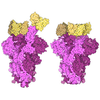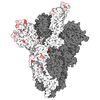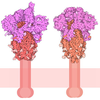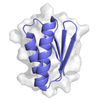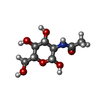[English] 日本語
 Yorodumi
Yorodumi- PDB-9aru: COVA2-15 fragment antigen binding in complex with SARS-CoV-2 6P-m... -
+ Open data
Open data
- Basic information
Basic information
| Entry | Database: PDB / ID: 9aru | |||||||||||||||||||||||||||
|---|---|---|---|---|---|---|---|---|---|---|---|---|---|---|---|---|---|---|---|---|---|---|---|---|---|---|---|---|
| Title | COVA2-15 fragment antigen binding in complex with SARS-CoV-2 6P-mut7 S protein | |||||||||||||||||||||||||||
 Components Components |
| |||||||||||||||||||||||||||
 Keywords Keywords | VIRAL PROTEIN / SARS-CoV-2 / neutralizing antibody / coronavirus | |||||||||||||||||||||||||||
| Function / homology |  Function and homology information Function and homology informationsymbiont-mediated disruption of host tissue / Maturation of spike protein / Translation of Structural Proteins / Virion Assembly and Release / host cell surface / viral translation / host extracellular space / symbiont-mediated-mediated suppression of host tetherin activity / Induction of Cell-Cell Fusion / structural constituent of virion ...symbiont-mediated disruption of host tissue / Maturation of spike protein / Translation of Structural Proteins / Virion Assembly and Release / host cell surface / viral translation / host extracellular space / symbiont-mediated-mediated suppression of host tetherin activity / Induction of Cell-Cell Fusion / structural constituent of virion / entry receptor-mediated virion attachment to host cell / membrane fusion / Attachment and Entry / host cell endoplasmic reticulum-Golgi intermediate compartment membrane / positive regulation of viral entry into host cell / receptor-mediated virion attachment to host cell / host cell surface receptor binding / symbiont-mediated suppression of host innate immune response / receptor ligand activity / endocytosis involved in viral entry into host cell / fusion of virus membrane with host plasma membrane / fusion of virus membrane with host endosome membrane / viral envelope / symbiont entry into host cell / virion attachment to host cell / SARS-CoV-2 activates/modulates innate and adaptive immune responses / host cell plasma membrane / virion membrane / identical protein binding / membrane / plasma membrane Similarity search - Function | |||||||||||||||||||||||||||
| Biological species |   Homo sapiens (human) Homo sapiens (human) | |||||||||||||||||||||||||||
| Method | ELECTRON MICROSCOPY / single particle reconstruction / cryo EM / Resolution: 3.9 Å | |||||||||||||||||||||||||||
 Authors Authors | Ozorowski, G. / Turner, H.L. / Ward, A.B. | |||||||||||||||||||||||||||
| Funding support |  United States, 1items United States, 1items
| |||||||||||||||||||||||||||
 Citation Citation |  Journal: Plant Biotechnol J / Year: 2025 Journal: Plant Biotechnol J / Year: 2025Title: Plant-produced SARS-CoV-2 antibody engineered towards enhanced potency and in vivo efficacy. Authors: Steven W de Taeye / Loïc Faye / Bertrand Morel / Angela I Schriek / Jeffrey C Umotoy / Meng Yuan / Natalia A Kuzmina / Hannah L Turner / Xueyong Zhu / Clemens Grünwald-Gruber / Meliawati ...Authors: Steven W de Taeye / Loïc Faye / Bertrand Morel / Angela I Schriek / Jeffrey C Umotoy / Meng Yuan / Natalia A Kuzmina / Hannah L Turner / Xueyong Zhu / Clemens Grünwald-Gruber / Meliawati Poniman / Judith A Burger / Tom G Caniels / Anne-Catherine Fitchette / Réjean Desgagnés / Virginie Stordeur / Lucie Mirande / Guillaume Beauverger / Godelieve de Bree / Gabriel Ozorowski / Andrew B Ward / Ian A Wilson / Alexander Bukreyev / Rogier W Sanders / Louis-Philippe Vezina / Tim Beaumont / Marit J van Gils / Véronique Gomord /      Abstract: Prevention of severe COVID-19 disease by SARS-CoV-2 in high-risk patients, such as immuno-compromised individuals, can be achieved by administration of antibody prophylaxis, but producing antibodies ...Prevention of severe COVID-19 disease by SARS-CoV-2 in high-risk patients, such as immuno-compromised individuals, can be achieved by administration of antibody prophylaxis, but producing antibodies can be costly. Plant expression platforms allow substantial lower production costs compared to traditional bio-manufacturing platforms depending on mammalian cells in bioreactors. In this study, we describe the expression, production and purification of the originally human COVA2-15 antibody in plants. Our plant-produced mAbs demonstrated comparable neutralizing activity with COVA2-15 produced in mammalian cells. Furthermore, they exhibited similar capacity to prevent SARS-CoV-2 infection in a hamster model. To further enhance these biosimilars, we performed three glyco- and protein engineering techniques. First, to increase antibody half-life, we introduced YTE-mutation in the Fc tail; second, optimization of N-linked glycosylation by the addition of a C-terminal ER-retention motif (HDEL), and finally; production of mAb in plant production lines lacking β-1,2-xylosyltransferase and α-1,3-fucosyltransferase activities (FX-KO). These engineered biosimilars exhibited optimized glycosylation, enhanced phagocytosis and NK cell activation capacity compared to conventional plant-produced S15 and M15 biosimilars, in some cases outperforming mammalian cell produced COVA2-15. These engineered antibodies hold great potential for enhancing in vivo efficacy of mAb treatment against COVID-19 and provide a platform for the development of antibodies against other emerging viruses in a cost-effective manner. | |||||||||||||||||||||||||||
| History |
|
- Structure visualization
Structure visualization
| Structure viewer | Molecule:  Molmil Molmil Jmol/JSmol Jmol/JSmol |
|---|
- Downloads & links
Downloads & links
- Download
Download
| PDBx/mmCIF format |  9aru.cif.gz 9aru.cif.gz | 714.6 KB | Display |  PDBx/mmCIF format PDBx/mmCIF format |
|---|---|---|---|---|
| PDB format |  pdb9aru.ent.gz pdb9aru.ent.gz | 584.1 KB | Display |  PDB format PDB format |
| PDBx/mmJSON format |  9aru.json.gz 9aru.json.gz | Tree view |  PDBx/mmJSON format PDBx/mmJSON format | |
| Others |  Other downloads Other downloads |
-Validation report
| Summary document |  9aru_validation.pdf.gz 9aru_validation.pdf.gz | 2.7 MB | Display |  wwPDB validaton report wwPDB validaton report |
|---|---|---|---|---|
| Full document |  9aru_full_validation.pdf.gz 9aru_full_validation.pdf.gz | 2.8 MB | Display | |
| Data in XML |  9aru_validation.xml.gz 9aru_validation.xml.gz | 113.5 KB | Display | |
| Data in CIF |  9aru_validation.cif.gz 9aru_validation.cif.gz | 175.6 KB | Display | |
| Arichive directory |  https://data.pdbj.org/pub/pdb/validation_reports/ar/9aru https://data.pdbj.org/pub/pdb/validation_reports/ar/9aru ftp://data.pdbj.org/pub/pdb/validation_reports/ar/9aru ftp://data.pdbj.org/pub/pdb/validation_reports/ar/9aru | HTTPS FTP |
-Related structure data
| Related structure data |  43794MC  9b82C M: map data used to model this data C: citing same article ( |
|---|---|
| Similar structure data | Similarity search - Function & homology  F&H Search F&H Search |
- Links
Links
- Assembly
Assembly
| Deposited unit | 
|
|---|---|
| 1 |
|
- Components
Components
| #1: Protein | Mass: 141328.359 Da / Num. of mol.: 3 Mutation: R682G, R683S, R685S, V705C, F817P, T883C, A892P, A899P, A942P, K986P, V987P Source method: isolated from a genetically manipulated source Source: (gene. exp.)  Gene: S, 2 / Cell line (production host): HEK293F / Production host:  Homo sapiens (human) / References: UniProt: P0DTC2 Homo sapiens (human) / References: UniProt: P0DTC2#2: Antibody | Mass: 13764.215 Da / Num. of mol.: 3 Source method: isolated from a genetically manipulated source Source: (gene. exp.)  Homo sapiens (human) / Cell line (production host): HEK293F / Production host: Homo sapiens (human) / Cell line (production host): HEK293F / Production host:  Homo sapiens (human) Homo sapiens (human)#3: Antibody | Mass: 12432.875 Da / Num. of mol.: 3 Source method: isolated from a genetically manipulated source Source: (gene. exp.)  Homo sapiens (human) / Production host: Homo sapiens (human) / Production host:  Homo sapiens (human) Homo sapiens (human)#4: Polysaccharide | 2-acetamido-2-deoxy-beta-D-glucopyranose-(1-4)-2-acetamido-2-deoxy-beta-D-glucopyranose Source method: isolated from a genetically manipulated source #5: Sugar | ChemComp-NAG / Has ligand of interest | N | Has protein modification | Y | |
|---|
-Experimental details
-Experiment
| Experiment | Method: ELECTRON MICROSCOPY |
|---|---|
| EM experiment | Aggregation state: PARTICLE / 3D reconstruction method: single particle reconstruction |
- Sample preparation
Sample preparation
| Component | Name: COVA2-15 fragment antigen binding in complex with SARS-CoV-2 6P-mut7 S protein Type: COMPLEX / Entity ID: #1-#3 / Source: MULTIPLE SOURCES |
|---|---|
| Source (natural) | Organism:  |
| Source (recombinant) | Organism:  Homo sapiens (human) Homo sapiens (human) |
| Buffer solution | pH: 7.4 |
| Specimen | Conc.: 4.2 mg/ml / Embedding applied: NO / Shadowing applied: NO / Staining applied: NO / Vitrification applied: YES |
| Specimen support | Grid material: COPPER / Grid mesh size: 400 divisions/in. / Grid type: Quantifoil R1.2/1.3 |
| Vitrification | Instrument: FEI VITROBOT MARK IV / Cryogen name: ETHANE / Humidity: 100 % / Chamber temperature: 277 K |
- Electron microscopy imaging
Electron microscopy imaging
| Experimental equipment | 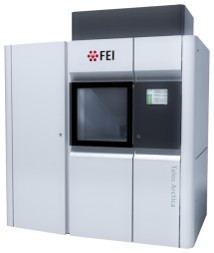 Model: Talos Arctica / Image courtesy: FEI Company |
|---|---|
| Microscopy | Model: FEI TALOS ARCTICA |
| Electron gun | Electron source:  FIELD EMISSION GUN / Accelerating voltage: 200 kV / Illumination mode: FLOOD BEAM FIELD EMISSION GUN / Accelerating voltage: 200 kV / Illumination mode: FLOOD BEAM |
| Electron lens | Mode: BRIGHT FIELD / Nominal magnification: 36000 X / Nominal defocus max: 2000 nm / Nominal defocus min: 700 nm / Alignment procedure: COMA FREE |
| Specimen holder | Cryogen: NITROGEN / Specimen holder model: FEI TITAN KRIOS AUTOGRID HOLDER |
| Image recording | Electron dose: 50 e/Å2 / Detector mode: COUNTING / Film or detector model: GATAN K2 SUMMIT (4k x 4k) / Num. of real images: 2770 |
- Processing
Processing
| EM software |
| ||||||||||||||||||||||||
|---|---|---|---|---|---|---|---|---|---|---|---|---|---|---|---|---|---|---|---|---|---|---|---|---|---|
| CTF correction | Type: PHASE FLIPPING AND AMPLITUDE CORRECTION | ||||||||||||||||||||||||
| Symmetry | Point symmetry: C3 (3 fold cyclic) | ||||||||||||||||||||||||
| 3D reconstruction | Resolution: 3.9 Å / Resolution method: FSC 0.143 CUT-OFF / Num. of particles: 25728 / Symmetry type: POINT | ||||||||||||||||||||||||
| Refine LS restraints |
|
 Movie
Movie Controller
Controller


 PDBj
PDBj